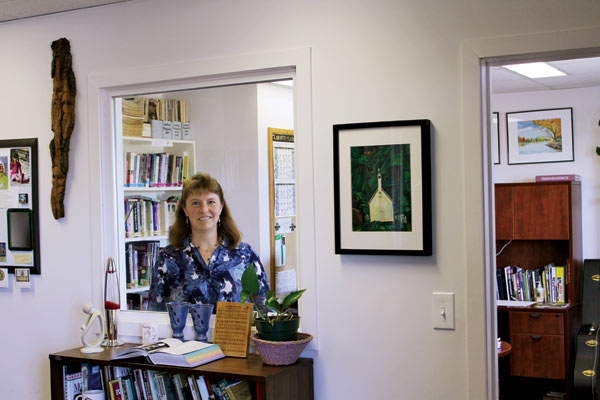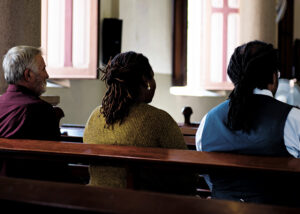Ontario pastor Kevin Peters-Unrau tells a Kafkaesque story of what happened when he volunteered to work with children in his community.
“I had difficulty getting a police check because last July they changed the laws . . . so if you have the same birthday as a registered sex offender, you have to now be fingerprinted,” he says. “The earliest appointment was for six weeks later. So then I show up there, I have questions: ‘Does this mean I’m now in the RCMP database?’ ‘Who has access to this biometric information now for all time?’ ”
He was told his fingerprints would be compared with those in the registry and returned to him with no copy kept. “Now it’s all digital, so it’s not like I can prove that they haven’t kept a copy, but presumably this is the case,” he says. “So if I trust the system, I trust that I won’t be in it.”
A month or so after the fingerprinting, which he understood was a free police service, he got a call saying, “ ‘You need to come in and bring a certified cheque to pay for them.’ By this point we’re so far along in the [church] program . . . I never went in and paid for it or picked it up.”
Despite his experience with police bureaucracy, Peters-Unrau is firmly supportive of church safety policies—even ones that require fingerprinting. “A good safety policy helps point the direction for people who are wondering what they can and can’t do. There should be information [in the policy] that helps people do their job better,” he says.
Frustrations with safety policies
In 2012, safety policies are commonplace in churches, and so are the accompanying frustrations: increased administration, volunteers reluctant to “jump through the hoops” for proper approval, false positives with police checks, extra expenses, and a limiting of spontaneity, especially in programs dealing with youths.
Cheryl Dyck, office administrator at Cedar Valley Mennonite Church, a Mennonite Church B.C. congregation, knows the difficulties of implementing a safety policy. “It’s been a mixed response, due to the fact that it’s one more thing they have to do in order to volunteer,” she says. “Others think that it’s a wonderful thing for the safety of our children. Of course, you get both sides always.”
Safety policies are meant to help the church consciously and consistently be a place where people are physically, emotionally and spiritually safe. On its website, MC Saskatchewan states that, “In addition to spiritual commitment, the church has moral, legal and societal obligations to ensure a safe environment for children, youth and vulnerable adults participating in church programs.”
The implementation of new policies, however, can leave long-time church members resentful and feeling they are not trusted the way they used to be.
Larry Jantzi has served with Mennonite Mutual Insurance (MMI) in Alberta for 30 years, and has witnessed the changing attitudes. “The shift I see is that, historically, Mennonite congregations have been fairly rural based,” he says. “You didn’t see a lot of change in the people. You kind of knew them from way back when and knew who their parents were. Nowadays, church membership is not as prevalent. You’ve got a lot more people church shopping. . . . There’s a lot more changeover in the composition of congregations, and that leads to some additional challenges when it comes to at what point they can be involved in certain ministries in the church.”
An opportunity for outreach
While the high mobility of church members may be a cause for lament, it can also be viewed as an opportunity for outreach. In 2003, MC B.C. mandated its congregations to adopt a “take care” policy, a policy that area church minister Garry Janzen sees as helping to welcome strangers to church.
“If we want to invite the children from the neighbourhood, the people in the neighbourhood don’t know that we have this long history, they don’t know what faithfulness to Jesus really looks like,” he says. “They don’t know that we can be trusted. If we care about our neighbourhood and want to reach our neighbourhood, we’re doing it [creating a safety policy] for them, so that they can look at us and . . . know that if they bring their children, they bring them to a safe place. . . . It’s not about your church family or the people who know you trusting you, it’s about people who don’t know you trusting you.”
Increased awareness of incidents of abuse in recent media coverage and encouragement for victims to speak out are pushing churches to consider that there may be both victims and abusers in their pews and among their leadership. Even if this is not the case, congregations have a responsibility to both prevent abuse and to be ready to minister to hurting people who may attend their programs in the future.
Ten years ago, Mennonite Central Committee compiled a resource packet called “Making Your Sanctuary Safe,” which acknowledges that “incidents of molestation can occur in any church—including yours. . . . Churches are by nature trusting and unsuspecting institutions. . . . These qualities can make a church susceptible to incidents of child molestation.”
Good safety policies demonstrate trustworthiness, instead of assuming it.
Safe policies protect everyone, not only children
Kirsten Schroeder, MC Canada’s director of human resources, says that safe policies are important “because we are the church. . . . We’re a model to the rest of the world about how community could look. And so, of course, we want our vulnerable people to be safe, but we also want to provide safety for those people who have encountered problems with these kinds of issues.”
While safety policies often focus on protecting children, Schroeder points out that they also function in the process of redemption. Firm boundaries and clear procedures may allow former perpetrators to experience healing as part of a faith community.
A congregation working with a past offender displays its safety policies along with committee member names on a bulletin board. There are agreements between this individual and the committee about where he may go and several people are assigned to befriend and observe him while he is at church. He regularly attends a circle of support and accountability outside of the church and is doing well. “Often people who are offenders are isolated,” the church pastor says. “This gives them a chance to belong and be accountable.”
Good policies can also function to help pastors and lay leaders set visitation practices, minimizing risk to themselves and congregants. Pastoral work involves being with people in crisis, and because pastors often find themselves alone with vulnerable people, the possibility of boundary-crossing in relationships—or of being misunderstood or falsely accused—is high.
Karen Martens Zimmerly is MC Canada’s denominational minister. “As pastors, we don’t always see ourselves as in a position of power, particularly in the Mennonite church,” she says. “In the intensity of helping the person, we are not always necessarily thinking about that difference in power and how our help will be perceived. Yet the onus is on us, in that leadership as the pastor, to not only care for the crisis, but take care for the relationship in that crisis, and that we provide the healthiest leadership and boundaries.”
Policy roadblocks in youth ministry
It is in youth ministry that safety policies are in the most danger of becoming roadblocks to ministry. Providing full details of events, requiring parents to sign permission forms, finding enough approved youth sponsors and drivers, and assuring teenagers are not inappropriately alone with an adult or each other are daunting tasks and can raise the ire of parents, youths and youth workers.
Such hallmarks of youth as spontaneity and creativity can be severely limited by safety policies, according to Anna Rehan, MC Saskatchewan youth minister, who notes that youths often show up at the last minute for events, making it difficult to ensure all the permission and supervision requirements are met.
The thing that most frustrates Rehan, however, is how policies can inhibit one-on-one conversations between adults and teens. “Policy says you can’t be alone with someone,” she says. “When it starts inhibiting ministry, there’s a problem.”
Rehan has found that young people are more likely to open up about important issues when they are with a trusted adult and peer pressure is not at play. Mentorship programs and pairing adults and teens are valuable as places where youths can speak to adults other than their parents about faith and life issues. These programs are especially problematic for safety policies and difficult for Rehan, as she tries to help congregations set them up.
There are ways to ensure safety and still have one-on-one encounters, but extra thought and preparation are necessary. When Rehan is alone with a young person, she tries to meet in a public place, such as a coffee shop, but transportation for youths who do not drive complicates matters. Rehan checks with parents to make sure they agree with her driving or meeting with their child. “It becomes so cumbersome, even with people driving kids,” she says. “You always have to have two adults. It just gets to be so cumbersome that you can’t do ministry, and then it’s not helpful.”
Rob Brown was a youth pastor for 13 years, and has been lead pastor for four years at Eden Mennonite Church, Chilliwack, B.C. When the “take care” program came into effect, he saw the awkwardness of implementation and acknowledged the vast amount of work churches had to do. In spite of the hassle, Brown says, “I don’t think it ever blocked [ministry to youth]. It’s being very proactive about having it become a safe place and being a good steward of your commission, your ministry. You have to be a good steward of providing that as a safe place. It’s very necessary.”
Like Rehan, Brown notes that transportation for youths is a complication. “We had to take extra care to be above reproach,” he says. “The safety thing just forced us to be more healthy.”
Safety policies are here to stay
That safety policies are critically important is widely acknowledged among church leadership, and the policies are here to stay. “They are quite important because of the increased litigation so prevalent in our society, and the higher responsibility and duty of care that institutions like a church owes to minors in particular,” Larry Jantzi of MMI says.
While fulfilling insurance requirements is not the foremost reason for the adoption of safe policies, it is an impor-tant consideration. Peters-Unrau says it’s about more than “butt-covering,” that adequate coverage is part of responsible ministry. If someone was seriously harmed during a church event, “I want to make sure that money is there to help them out,” he says.
While they may cause significant hassles that have to be worked out, safety policies also have the potential to be powerful enablers of ministry. They can help welcome and witness to strangers by clearly demonstrating a church’s desire to be a safe place for the vulnerable and those in search of redemption. They can be a catalyst to conversation on difficult topics. And they support leaders as they strive to model healthy relationship boundaries and protect them from false accusations.
“They are a very good thing,” Schroeder concludes. “It was one of the things that used to keep me up at night when I started working here and knowing that we had created the perfect storm for potential misuses of power. I am so grateful to churches for picking up on this topic and overcoming their uncomfortableness with it. . . . We encourage those churches who don’t yet have a policy, to undertake this task because it really is a very good thing to have in place for all members.”
For discussion
1. Does your congregation have a safe church policy? Whose responsibility is it to implement and review the policy? What has been the effect of the policy? How does it relate to Jesus’ words in Matthew 18:5-7?
2. How important are safe church policies? Do they hinder volunteers from getting involved? Do they hamper youth programming? Do they help neighbours feel comfortable that their children are safe? Do they remind church leaders of the implications of abusing the trust of others?
3. Have you personally encountered the Canadian Food Inspection Agency? How important is the work that it does? In what situations do food safety inspection laws apply to churches? How concerned should we be about food safety? How much of our safety is ultimately dependent on God (Psalm 4:8)?
4. Is the push for safety/food policies and laws primarily driven by fear of lawsuits? What changes in society have led to an increase of such regulations? How effective are policies and laws in bringing about desired behaviour? Are there other things our churches could be doing to improve safety?









Leave a Reply
You must be logged in to post a comment.